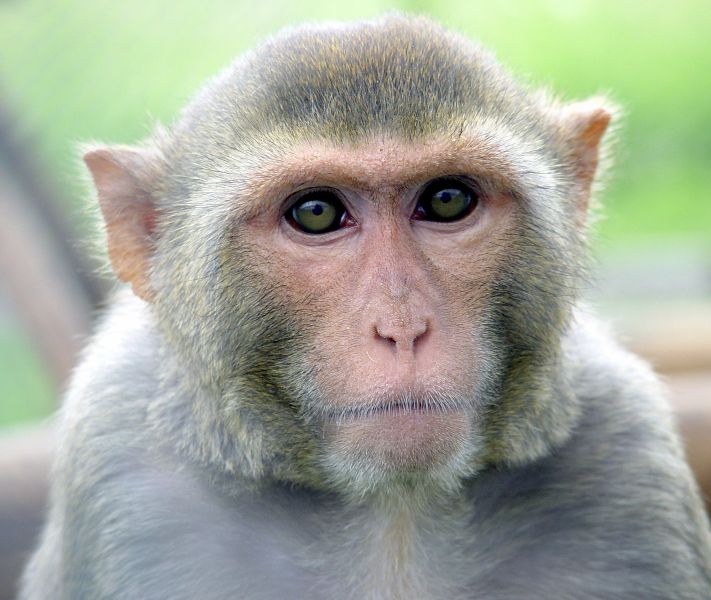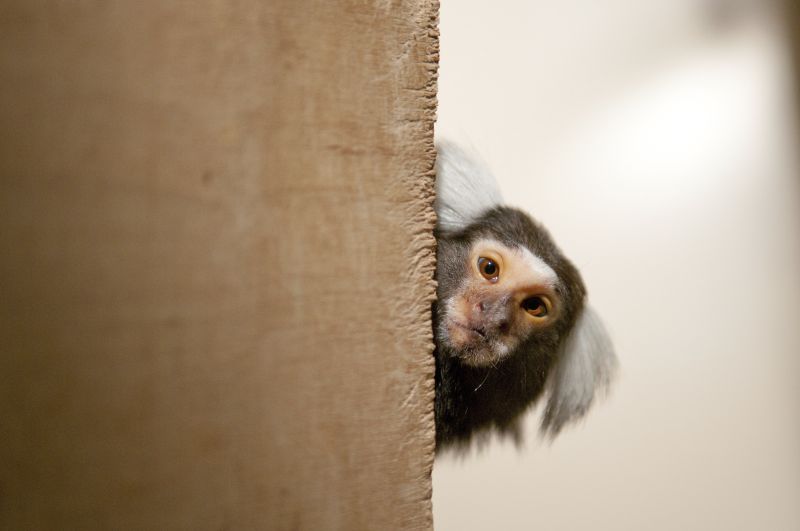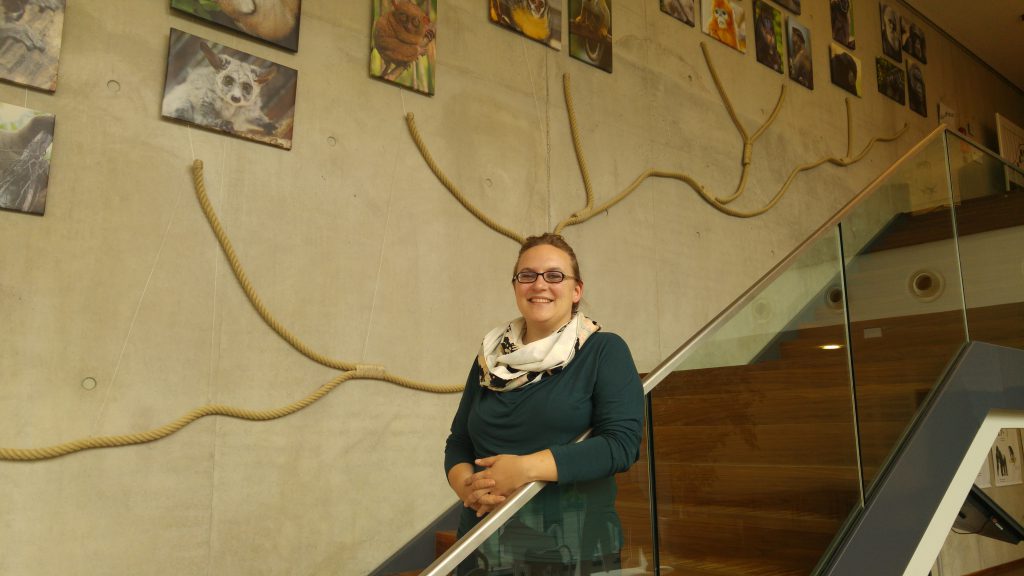
“When someone asks me about my job, I don’t really expect understanding. But I do expect the person to take the time to let me explain,” Valeska Stephan says. As a Postdoc at the German Primate Center (Deutsches Primatenzentrum, DPZ) she carries out experiments on rhesus macaques. The Primate Center celebrates its 40th anniversary this year and highlights its primate biological research in the latest exhibition. I took this opportunity to finally visit the DPZ. DPZ press officer Dr. Susanne Diederich took me on a tour through the “Primates” exhibition and gave me some background information about the exhibits. Even if you don’t get a tour, you can still learn many things about our close relatives and see experimental equipment that has accompanied the DPZ scientists into the savannah or the rain forest.
About sensitive exhibits and expeditions to the Amazon
“Follow me into the favorite room among my colleagues,” Dr. Diederich tells me. There, tropical sounds and dimmed light draw attention to South American primate species and create a relaxed atmosphere for a biologist’s lunch break. This way the DPZ field station in the Peruvian rain forest is thematized. “The taxidermy of that black capuchin is from the 18th century, UV light would ruin it,” the press officer explains to me. One of her colleagues slips behind the fence to read out the actual year to me from the pedestal: 1758, you really don’t want to take a risk!
Other field stations are located in Madagascar, Senegal and Thailand. “Our primate biologists commit themselves a lot to monkey preservation in the countries of origin,” Dr. Diederich says. After all, about 60 percent of all species are endangered! On site, the scientists bargain about the establishment of protection territories, work hand in hand with park rangers and visit schools to draw attention to the necessity of species conservation. Through cooperation with local universities students come over to the DPZ for internships. Likewise, biology students from Göttingen can join the expeditions, e.g. to collect material for their bachelor thesis in Madagascar. What the scientists thereby aim to find out about the primates and what they’re doing to achieve new insights: the exhibitions will give you the answers.

Later, I’m standing in the DPZ’s cafeteria in front of a glass plate vis-à-vis with some common marmosets. Next to me Valeska says, “Absolutely cute but unfortunately they stink.” In the former I can only agree with her – how they stick out their little tongs to me, the tiny head tilted and with button eyes fixing me. Regarding the scent, take a nose full of the orange plastic cup of the exhibit next to the cage on occasion!
Within the cage, the little primates restlessly climb up and down the ropes, twigs etc. “They need lots of so called enrichment to allow them behaving naturally,” Valeska says. In cooperation with the University Medical center the DPZ uses these monkeys to improve cochlea hearing implants. In contrast, Valeska measures the activity of certain brain regions of rhesus macaques using electrodes to explore their contribution to visual perception. She is obviously fascinated by her research, “I can kind of hear the brain thinking – amazing!” It’s only when she is on parties that she is tempted to simply say she is a biologist.
What it means to experiment on primates
Valeska has been working at the DPZ since ten years. Already during her studies, she was passionate about neuroscience and aware of the necessity of animal models. She started with an intership at the DPZ, trying to find out, how that work would look like in reality. “From the very first moment my supervisor was very clear about the importance of respect and responsibility for the animals,” she tells me. After having made that experience she has said to herself, “Yes, I can do that.”
What I haven’t been aware of before talking to Valeska: the PhD students work with the same primates during their entire thesis. They assist in every surgery that is done on their animals and subsequently they monitor them for the first 24 hours. If one of them gets sick they get a call from the animal attendant, no matter what day or night time it is, they would come over and wait for the doctor together with their primate.
“Yes, you develop a relationship to your animals, that is unavoidable,” Valeska says. After all, they see them every day, they all do have names. “But one must be aware of the fact that they’re no pets and that they must fulfill a task,” she goes on. After the completion of the project there is always a question: is there still anything to do for him? And yes, there have also been colleagues who couldn’t deal with that responsibility. Luckily, she was able to find a follow-up project for her favorite rhesus macaque “Zorro” after her thesis and she was still visiting him daily. “I liked his chubby, comfy, grumpy character. Pasta was his favorite dish,” she tells me.

In the DPZ’s foyer ther is a display is showing images from a webcam installed in the rhesus macaques’ open-air enclosure. By the way, this is already the second cam as her predecessor didn’t resist to the monkeys’ curiosity. “Look at those three, they’re doing the grooming that I’ve told you about,” Valeska says. This primate typical behavior strengthens friendships and determines social ranks. “Have you known that it’s been rhesus macaques that caused the death of New Delhi’s vice-mayor in 2007?” she asks me then. One should not underestimate the monkeys with their long teeth. “Looking them directly in the face or smiling for example is quite a bad idea,” she says. Therefore, she wouldn’t advise anyone to pose with those exemplars in India for a vacation snap!
It’s your turn!
Finally, I’ve made it there – to the DPZ! The exhibition shows the wonderful variety of non-human primates with which we have so much in common. I became aware of the fact that a high portion of research at the DPZ is also dedicated to their conservation – and not only serving the humans. In addition, I left the DPZ with a good feeling, knowing that people who work there, do their research in a responsible way and in a way, live it. I’ve asked some people in my social environment: unsurprisingly, quite a few biologists have already been there. In contrast, others rather not. So, what about you?
Info:
The exhibition is in German, however, guided tours are possible in English. You have the chance to visit “Primates” until February 28th 2018 from Monday to Thursday between 9 am and 4 pm: Just step into the DPZ’s foyer.





